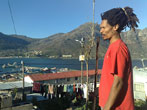The Uprising of Hangberg

South African poet and writer Rustum Kozain reviews ‘The Uprising of Hangberg’, Dylan Valley and Aryan Kaganof's portrayal of two days of violence in Cape Town. Watch a . This article first appeared on the website of The Africa Report.
Long-running tensions between residents of Hangberg in Cape Town's Hout Bay and city council authorities once again boiled over in September 2010, with police firing rubber bullets (some claim live ammunition as well) on residents, who responded (or initiated) with rocks and petrol bombs.
Situated above the bay, Hangberg is a neighbourhood of mainly working-class ‘coloured’ people. Fishing is the area's primary economic activity, stretching back several generations.
The city’s story is that it had an agreement with the community, struck in 2008 with Helen Zille, then mayor of Cape Town, now premier of the Western Cape. Development was on the cards as long as there were no ‘new’ arrivals building temporary dwellings on and above a firebreak on the mountain. The city then discovered that there were a number of ‘illegal’ structures on the firebreak. At a meeting on 17 September 2010, Zille insisted that residents should take down those dwellings. She was heckled and left the meeting with the issue unresolved.
On 21 September, the police entered Hangberg with the aim of demolishing these dwellings. A confrontation ensued, leading to the police action and 75 people injured. Four people lost their eyes, including 22-year old Dylon Egypt, who has a rubber bullet lodged in his head. Removal might lead to brain damage and he is almost certain of having seizures for the rest of his life.
‘The Uprising of Hangberg’ is a documentary that looks at this story from the residents’ perspective. Naturally, the main question is: who started the violence? The documentary sides with the residents, who maintain that the shooting was unprovoked: shots were fired first and then stones and petrol bombs followed.
The filmmakers slow down some footage shot by a resident, but there is a jump in the footage and one can’t see who fired or threw stones first. It is clearly not a cut, and therefore it doesn’t seem to have been manipulated through editing. It is possible that the camera operator inadvertently touched the standby button on the camera (The operator is walking over uneven ground while filming the police phalanx confronting residents behind a barricade in a street below and about 100m away).
Notwithstanding the inconclusive nature of this footage, the residents interviewed in the documentary are all adamant that the police fired first, and there is little reason to doubt them. And this, I find, is the strength of the film. The residents speak strongly and with conviction to the camera. While one or two of the interviewees play-it up, the testimony is straight up and the interviews make for gripping viewing.
Some troubling issues emerge. Some of the community activists asked to see the required court order for the demolition of the dwellings, but were reportedly dismissed with contempt by the police. In addition to people having lost eyes, there are several people with facial wounds, and questions must be raised about the police aiming at people’s heads and faces. Was this an instruction, an order? Or was it police incompetence? Two of the people who lost eyes, Ikram Halim and Dylon Egypt, also claim to have been shot at as close a range as half a metre. That’s a shotgun in your face.
In news interview clips included in the film, Zille portrays Hangberg as being held to ransom by a group of Rastafarians she characterises as violent druglords. Residents scoff at this and claim the Rastafarians as welcome and helpful members of the community. And so, while the community is generally considered as fractious and divided, the events of 21 and 22 September have provided it with an impetus for solidarity.
There is something about the disdainful approach of the police, whether white or black (and discernible in their body language), showing the continuities that exist between apartheid state forces and those of our neo-liberal present. While controversy may continue over who caused the violence, the police come across as unnecessarily brutal. A young boy, for instance, was detained and reportedly threatened with death while having a gun pointed at his groin. Female residents report with resentment how police swore at them as naaiers (whores).
Neglected by a previous ANC city council, and now mistreated by the DA, there’s also a resentment discernible in the community that stretches back to the country’s colonial and apartheid past. Some residents are old enough to remember the Group Areas Act, and they wonder whether, ultimately, it is not the view they have of the bay that has become a sought after commodity for middle-class new arrivals.
BROUGHT TO YOU BY PAMBAZUKA NEWS
* This article first appeared on the website of The Africa Report.
* Rustum Kozain is a writer from Cape Town. His debut volume ‘This Carting Life’ was published in 2005 and he has been awarded both the Ingrid Jonker Poetry Prize and Olive Schreiner Award.
* Please send comments to [email protected] or comment online at Pambazuka News.

